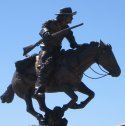
Joe's Stories from the Road
for the month of July 05
July 1
Statues, Coal, Devil’s Tower, Buffalo Jump, Gambling
Wyoming is green, green, green this year. For the past several years they have starved for rain. But now, the local folks are elated that the rains just keep coming. From Sheridan, the prairies were just awesome. Rolling in green as far as the eye could see. I stopped at Gillette for an hour or two before going to my hotel. Just checking out the town. On one of their streets I saw a number of interesting life size bronze statues. As I took photos of them, two city workers stopped to talk to me. I asked them how they could afford all the expensive statues. They said they couldn’t but they had cut a deal with several artists. They pay the artist $500 to display their art on the streets for one tourist season. The city has the right to sell a statue and earns a percentage. Last year they sold over a dozen out of 18 displayed. Great idea for everyone. They said that not one piece of art was vandalized
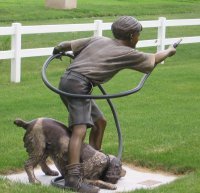

I had earlier photographed some of their coal mining operations and mentioned this to the men from the city. They were excited to talk about their riches in coal. Looking at the veins of coal maybe 60 feet deep and almost on top of the ground I could understand why. One said that Gillette has enough coal to last the US for 200 years. He said it as if that were eons of time. I told him that I had lived 62 years and that 200 years is really a short period of time. What does Gillette do after 200 years and what do the rest of us who need the coal do after 200 year? Just a thought.
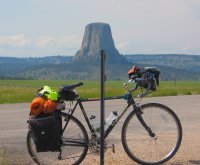
At Devil's Tower National Monument
I went north at Morcroft to visit Devil’s Tower.
That was our first National Monument.
That big chunk of rock, standing 850 feet above the prairie,
still fascinates me to no end.
How do such things happen?
He does things in mysterious ways, I guess, just to confound us.
And our experts on the subjects are still pondering and arguing
on how it got there. They
have an idea how it got there but don’t really know for sure.
There are several Indian Legends that explain why it is there.
One is that several little Indian girls were out playing one day
and a huge bear threatened to kill them.
The little girls prayed to the Great Spirit to save them and the
rocks that they were standing on began to rise out of the earth. It rose
and rose until it was high in the air.
The bear attacked the rock and clawed its way trying to reach the
little girls- but no luck.
You can see the huge claw marks on the tower to this day.
So, the girls screamed and screamed and finally the braves came
and killed the bear. An
eagle fetched the girls off the 800-foot tall rock and brought them back
to the Indian camp and everyone was happy.
That sounds reasonable to me.
The experts are still scratching their heads.
They don’t buy that story.
Just a few miles west of Beulah, which has the lowest
elevation of any post office in Wyoming, I stumbled upon an awesome
find. Oh, a rancher told me
he was sharing that story with an easterner who thought that he meant
that the post office building was real short. Now lets talk about that
awesome find. Have you ever
heard of a Buffalo Jump?
Well, it is usually a cliff over which the Indians would stampede the
Buffalo to kill several at once so they could harvest the meat to eat
and the hides for clothes and tipis.
West of Beulah, when the state was building Interstate 90, they
found a large sinkhole on the prairie.
They excavated, found bones, and rerouted I 90.
The archeologists have learned that the sinkhole was used for
over 300 years as a Buffalo Jump.
The bones and Indian tools are 25 feet deep and 100 feet across.
It is known as the Vore Buffalo Jump and has been turned over to
the University of Wyoming.
There are plans to build a dome over it so people can see the rest of
the dig. And that will take
years. It is one of the
most complete and undisturbed sites ever found. I hope the photos
of the jump turn out well.
David will have them.

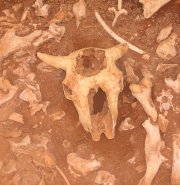
The Vore Buffalo Jump from the top, and the bottom.
I left there and proceeded on to Deadwood. Just before entering Deadwood I stopped to visit The Story of The Bison.It is an interpretive center for the story of the Buffalo on the great plains of America and the role that the Buffalos played in the European move westward and in the lives of the Native Americans. This center was planned and financed by Kevin Costner after he made the movie Dances With Wolves. At the center Costner built a Buffalo Jump and hired artists to sculpt Buffalo, Indians and Horses at the jump. Three Buffalos in bronze are actually upside down and falling into the pit. One Buffalo has gotten his horn under a horse’s chest and has raised him up. In the panic, the Indian is trying to either get off the horse or try not to get under the two animals. It is the most realistic work in bronze I have ever seen. You can feel the panic in the falling Buffalo and in those that have arrived at the cliff and are trying desperately to turn. You can see the terror in the horse’s faces and the anxiety in the Indians. Working a Buffalo Jump was not for the faint of heart. Until I saw this piece of art I never really thought about the drama, the fear and the hopelessness of the animals. And I really never thought about this being a life or death experience for the Indian. But they had to feed their families. Awesome!!!
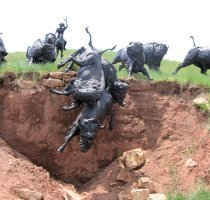
Sculptures from "The Story of the Bison" Interpretive Center
I proceeded onto Deadwood. That is the western town where the Black Hills Gold rush began. It was also the town where Wild Bill Hickok was killed at a gambling table. He and Calamity Jane are buried next to each other in the cemetery at Deadwood. The first time I saw Deadwood was in the winter of 1966. I was on a greyhound bus and we took a rest stop. I got off and looked around. There was about eight inches of snow on the ground. I rode a bus 12,000 miles before the ‘67 bicycle trip to check out the places that I wanted to visit and Deadwood was one of those places. Then, that very summer I rode into Deadwood on a bicycle. It was still an old Western town. You could almost smell the horses on the streets. If you listened real close you could hear the jingle of spurs strapped to the heels of cowboy boots and the background music of a player piano coming from a saloon. It wasn’t so this time. I never got off of the bicycle. I rode right through town. Didn’t even check out the saloon where Hickok was killed. They have successfully hidden the old western town that use to be there. Now it is a miniature Las Vegas. The jingle of spurs has been replaced with that horrifying sound of slot machines. I got a hotel room near Lead just a few miles up the road and the huge lobby of the hotel was crammed with slot machines. And that noise that they put off is annoying. I had to listen to it checking in and checking out and even eating breakfast the next morning. I guess that is what people want Deadwood to be. I regret that I will never be able to show my grandchildren the old Western town of Deadwood. It is hidden under layers of tinsel.
July 6
Dinosaurs and Mammoths, Black Hills, Badlands, Crazy Horse, Presidents\
I spent a week in the Black Hills of South Dakota and Badlands National Park. After I left Deadwood I stopped at Hill City. This town is the home of the famous Tyrannosaurus Rex dinosaur named Stan. It is also near the location where Sue, the T Rex was found. Stan is in a museum in Hill City and Sue was bought and sent to Chicago. I took a lot of photos of the collection for the school project and bought a couple of DVDs about the subject.
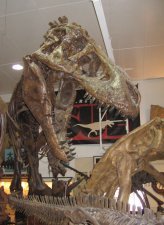

Dinosaurs!
Next visit was the Crazy Horse stone sculpture on a
mountain. It is huge and
very interesting. Photos
and DVDs also. What is
fascinating about the Crazy Horse project is that it was actually
started in the 1940s and is still being carved by jack hammers and
dynamite. The children and
wife of the man who started it at the request of the Indian Chiefs are
going on with the project.
The man who started it died in the 1980s.
I rode through Custer State Park, a 52,000-acre piece
of land set apart for family enjoyment by the state of South Dakota.
I rode Rocinante over the Iron Mountain Highway that goes to the
top of the Black Hills and then descends into the valley and back up to
Mount Rushmore. At Rushmore
I was disappointed at what progress has done there.
I circled the parking lot and they let me go in free because I
was riding a bicycle.
Everyone else pays $8.00 per car for parking.
I walked into the entrance expecting to see the Famous Americans
sculpted on the mountain.
That is not what I saw. The
government has built massive manufactured stone columns on both sides of
the entrance. And then hung
flags all over the columns.
So when you walk in you see two rows of columns with the flags flying.
You really can’t get a good look at the awesome sculpted art on
the mountain until you walk a couple hundred yards beyond the columns.
I talked to several local people about this and the people that I
talked to feel about the columns the way I do.
It just looks like a way to spend government money by giving
someone a generous contract for who knows why…..

President Washington.
In Rapid City I located the life size bronze statues
of the US Presidents. It is
impressive. So far, they
have about 16 of the presidents located on street corners.
The plan is to do every one of the US presidents.
The pose and clothes worn by each statue tells a story.
President Eisenhower is in a US Army General uniform standing
with one foot in Western Europe and the other in Great Britain.
President Carter has his jacket slung over his shoulder and he is
waving. President Nixon is
sitting in a rocking chair.
President Kennedy is walking with little John John when he was a boy and
President Kennedy is giving him a toy airplane.
President Jefferson is at a podium writing the constitution.
It was definitely worth stopping to see. I will visit again when
they have all of the presidents on the street corners.
My next stop was 55 miles out on the Great Plains to
visit the most incredible tourist trap in America.
That is Wall Drug Store in Wall, South Dakota.
A family went there to run a drug store in the 1940s but could
not making a go of it. The
wife suggested that they offer free ice water to the travelers across
the Plains. It worked.
Wall Drug now covers a city block and does over $10,000,000 in
business each year. They
have been written up in all the major magazines and newspapers and TV
programs in the country. I
love this country. I wish I had thought of this idea.
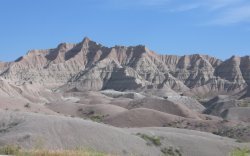
The Badlands
From there I rode 20 miles into Badlands National
Park. That is a desolate
landscape of eroded dirt.
It is world-class erosion. It is also the site of many ancient finds of
bones and tools of people and animals that do not exist anymore.
I rode back to Rapid City and then down to Hot
Springs, South Dakota, where they have found the remains of an ancient
sinkhole that was once used by the Woolly Mammoth as place to eat and
drink. The Mammoth would
get in the sinkhole that was filled with warm water and couldn’t get
out. So far they have
extracted 53 Woolly and Columbian Mammoths from the dig.
And what was interesting to me was that you can actually watch
the dig as it continues. It
is believed that it is over 40 feet deeper and may take 30 years to
complete the excavation.
Riding down the highway the last few days across the
Great Plains I have been thinking about what you may not know about what
goes through a bicyclist’s head as he rides these great stretches of
highway. On the Great
Plains there is always a wind blowing.
It blew in Alberta and Montana and now in South Dakota and
Nebraska. Since the
prevailing winds are coming from the Southwest I try to get on the road
by 6:30 to 7:00 am. The
winds get stronger in the afternoon and I am traveling toward the
southwest.
When you travel
here on a bicycle you look at a map and there are towns noted.
But that does not mean that there is a town there.
It may have been a town 20 or 50 years ago.
But not now. But it
is still a place and still has a name.
Usually the train took up its tracks and left town.
The town dies. But
it is still on the map.
For
a bicyclist, a town with a store is very important. When you think there
will be a town, but there isn’t, and you didn’t stock up enough water,
it gets a little scary. The
temperatures are in the mid 90s and sometimes higher so I have to be
sure that I always have water and food.
When you are on a bicycle, did you ever think about the drinking
water? Your water is always
the temperature of the air around you.
So for the last week my drinking water has been from the high 80s
to 100 degrees. You just
get use to it. Hot water
will hydrate the body just as well as cold or cool water.
In the Great Plains or America’s Grasslands there is almost never
a shade tree to get under when you stop to rest. You have to get use to
this, too. In the
grasslands of South Dakota the state lets the rancher cut and bail the
hay that has grown on the highway right of ways.
However, in Nebraska, they don’t cut a deal with the ranchers.
It gets cut and just lays there.
As I ride down the highway I look out toward a ranch house and
buildings and realize that they are five to ten miles off of the
highway. It would take some
getting use to in order to live there.
But there are plenty of hardy souls that make the Great Plains
their home. There is one
thing for sure. If you
needed a cup of sugar you wouldn’t walk over to the neighbors to borrow
some. The walk could be
twenty miles. The
Grasslands, The Prairies, or The Great Plains are names for the same
massive stretch of land in Middle America.
To me, it is mysterious, it is fascinating, it is beautiful, it
is awesome. But it can be a
bit unnerving when traveling through on a bicycle.
Since I have been on this bicycle trip I have talked to a
lot of local people and they have been very generous and helpful to me.
We have a very friendly and wholesome country.
It has been a huge pleasure for me to visit.
I look forward to meeting many, many more of you.
I have given you my web site and I know a lot of you are checking
in and I appreciate it. If you
haven’t looked backwards on the site you may not know that we are
promoting our beautiful Kentucky as a place to come and visit and even
live if you would like. I am
actually from the Red River Gorge and Natural Bridge State Park area of
Eastern Kentucky and of course I would like for you to visit our part of
the state. You will have to
travel through some beautiful parts of Kentucky to find us.
And while you are on our web site, look around at the other
projects that we are involved in.
And again thanks for checking in with the bicycle trip throughout
America. Later on, we will share
with you how the school children are involved in the bicycle trip.
July 23
Oregon Trail, a Farewell to Beanie and Mrs. Chip, On the (hot) Road Again
I have been back on the road on the bicycle for three days and I have been putting off writing to you. I am still struggling on how to start. Maybe I will tell you about going into Nebraska.

Chimney Rock marked the end of the Plains and the beginning of the Mountains for the travelers on the Oregon Trail
I left Rapid City and it took me four days to get to
the North Platte River. The
North Platte is an important part of American History.
It is where the Oregon Trail came through.
It is my second time this trip to be on the trail.
I also crossed it on the descent of Mount Hood into Portland.
At the North Platte, some pioneers drove their cattle and other
livestock up around the river while others went down river.
The North Platte was also an important landmark of the Mormon
Trail and of The Deadwood Trail, the gold rush trail to the Blackhills.
The Pony Express ran up this river as well.
During the Oregon Trail movement over 500,000 immigrants moved
west. Ten percent died of
disease and accidents- 50,000 people!
But the ones that made it opened up the west and eventually
allowed the United States to extend from coast to coast.
I stopped at Chimney Rock on the Platte.
It was the most often mentioned landmark in the journals of the
men, women and children that moved west on the Oregon Trail.
I ride the trail swiftly on a bicycle with rubber tires touching
hard asphalt. They walked or rode slowly in wagons on rutted dirt paths.
Now, there are restaurants and motels every few miles. Then, there was
nothing but the great North American landscape. Traveling by bicycle
today pales to utter insignificance when compared to those incredible
early Americans traveling by wagons pulled by cattle.
Then, I got the message from home that my very good
friend and almost son was not going to be able to beat the bone cancer
that had ravaged his body.
We had talked about the bicycle trip a lot.
Beanie was part of it from the beginning and he will always be a
part of it. Friends Ken
Thompson in Taylorsville and his son David, in Loveland, Colorado,
started making arrangements.
I still had about 30 miles to ride that day and a short time to
get to the Scottsbluff Airport before the last plane left for Denver.
That was on Friday and there were no flights on Saturday or
Sunday. For days, I had
been riding directly into the prevailing winds of the area. On the day I
received the message, I had been riding into a 15 mph head wind all day.
But after the message came the wind shifted to my back and I
averaged 22 mph and made it to the airport.
The local people and Homeland Security folks helped me break the
bicycle down and one person drove to town and found a bicycle box so we
could take it with me. Even
though I was late, the good folks at the Scottsbluff Airport told me,
“Joe, don’t worry. You WILL be on that plane.” I arrived in Kentucky an
hour too late. Beanie has
passed away. I was
heartbroken. Not only for
me but for all those incredible people who loved him and his awesome
wife, Sonya, and his three beautiful little girls.
At his funeral I was paid a most wonderful compliment.
Beanie’s teenage daughter, Sarah, came to me and said that she
was going to say something about her love and appreciation of her dad.
She would be representing all three of his children; Jerrica,
Timara, and herself. She
said that she wanted me to stand up with her just in case she couldn’t
get through what she had written.
She started out real well but broke down after the first or
second sentence. She looked
up to me and I didn’t think I was going to be able to finish it either.
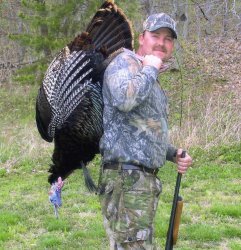
Timothy Dean "Beanie" Crabtree
12-21-66 - 7-9-05
After Beanie died, a most heart-warming tribute
occurred- a part of the great culture that is rural Kentucky.
All of Beanie’s brothers, cousins and friends dug his grave.
And while they dug they talked about this incredible brother of
theirs who had slipped the bonds
of earth and gone on. Each
person dug and each person had several stories to tell about our beloved
Beanie. Beanie, I love you
buddy, and I guess now you will know how this bicycle trip is going to
turn out and I won’t know until I pedal all of those miles in front of
me.
And while I was home another longtime and great friend
died. She was Louise Lee
Winchip. Mrs. Chip, as we
called her, had raised over 700 children in her lifetime while working
and managing the Dessie Scott Children’s Home for over 60 years.
In 1967, Mrs. Chip and the Dessie Scott Children mimeographed my
letters and sent them on to about 40 of my friends.
The children used their own allowances to buy the stamps to send
out my letters. Some of
those children are valuable adults in our communities and are my
friends. In 2002, Mrs. Chip
and I were given the honor of carrying the Olympic Torch for the Salt
Lake City Winter Games. We
had a ball and the Olympic Committee liked our story so well they
brought a film crew to Kentucky and made a short promo for the Winter
Olympics. Mrs. Chip was 88 years old.
Mrs. Chip, you were a powerful, Motherly, loving woman from our
Eastern Kentucky Mountains.
We are all proud to call you our friend.
We are going to miss your smiling face and the love you freely
dished out to all of us.
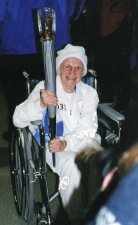
Louise Winchip and Olympic Torch
The first day back on the road I pedaled into
Cheyenne, Wyoming. I wasn’t
sure I was going to make it.
Ten days off the bicycle softens a person up.
But I made it. The
temperature was 97-degrees.
The Frontier Days Rodeo was starting the next day.
So I called my new friend, Deb Copenhaver, whom I stayed all
night with in Creston, Washington.
Deb was the world champion bronco rider in the mid 50s and he was
always in the money at the Cheyenne Frontier Days Rodeo.
There is a photo of him on this site (“Stories From the Road”-
month of May.) Anyway, Deb
and his wife Cheryl were pleased that I called and Deb informed me that
the American Cowboy Magazine had featured him in their July/August
issue. So I got me a copy.
He is awesome.
The next day was going to be a hot one and I am still
seeing nothing but grass, grass, grass.
The Great Plains just don’t want to let me go.
I rode out of Cheyenne at 6:45 in the morning.
At about 10:00 am on the bank marquee in Nunn and Ault, Colorado,
the temperature was 106 degrees.
I kept pouring in the water and Gatorade.
North of Loveland I finally saw the first harvesting of the wheat
that I had been watching grow all spring through Washington, Idaho,
Alberta, Montana, Wyoming, South Dakota and Nebraska.
Right now it has turned golden.
Sometimes you even think it sparkles.

So, thinking that this would be interesting to the
children when they get back in school in August, I hid Rocinante in high
grass and walked across the wheat field about a quarter mile so I could
get a close up photo of the combines at work.
Two combines were going down the field and after 20 minutes I was
able to get far enough ahead of them to be at the end of the field when
they turned around. One of
the big machines stopped and the driver opened the door to his
air-conditioned cab and climbed down to the ground to talk to me.
He couldn’t believe that I was traveling by bicycle.
He thought at first I meant that I was traveling on a motorcycle.
I told him that the bank sign in Nunn said it was 106 degrees.
He corrected me and said.
“Out here in this wheat field it is a hundred and ten.”
“How do you know that?” I asked.
He laughed and answered, “With that thermometer on the dash.”
I guess it was that hot on the asphalt as well.
I spent the night in Loveland with David Thompson and
got my laundry cleaned and few other chores caught up.
David, you are awesome and thanks for putting up with me and
getting me back and forth to the airport and back to my starting place
with the bicycle. It was
all beyond the call of duty- especially since I had just met you.
And I know your mom, Phyllis, from Taylorsville, Kentucky, is
going to enjoy her visit with you next week.
Today I gained 3,000 feet in altitude riding from
Loveland to Estes Park.
Tomorrow I will gain another 4,000 feet going over Trail Ridge Road in
Rocky Mountain National Park.
July 31
New Friends, Old Friends, Taking the High Road, the High Bridge, the High Mountain, and a Cowboy Conversation
Several people have ridden with me on the trip. One I forgot to mention was a Kentuckian named Stephen. My friend David in Loveland introduced us. Stephen rode with me through the Big Thompson Canyon along the river with the same name. He told me about the river flooding in 1976 due to a 14-inch rain. The flood was the greatest ever recorded in the area and several people lost their lives.
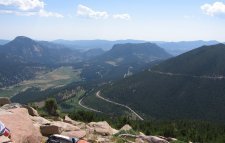
Trail Ridge Road
The next day, after some bicycle repairs, I headed
into Rocky Mountain National Park over the Trail Ridge Road.
Trail Ridge is the highest continuous highway in America.
It tops out at 12,183 feet above sea level.
The scenery is awesome. In 1967, I rode it alone.
This time I counted 28 bicycles going east and I could
account for about 24 going west.
For a dedicated bicyclist, the Trail Ridge Road is something
that one has to do. I
also met a lot of interesting people crossing in automobiles.
I talked at length to a family from Kansas.
I also met a family from India who now live in the United
States. Great
conversations.
I stayed in Winter Park and photographed the
entrance to the Moffatt tunnel. It takes the trains and a 6-foot
water line into Denver.
When the tunnel was built around the turn of the century it reduced
the trip between Denver and Salt Lake City by over a hundred miles.
The tunnel goes under the Rockies for over six miles.
I crossed over Berthoud Pass at 11,000 feet. It
was the 20th mountain pass that I have crossed during the
4,500 miles so far. I
had to pick my way through Idaho Springs and the canyon because now
Interstate 70 takes up most of the flat area.
But I did find bikeways through the canyon.
In one of the photos you will notice a bicycle bridge across
a narrow river. The
bridge is named for person riding his mountain bike nearby who was
attacked and killed by a mountain Lion.
I don’t want to meet any of those guys, either.

While riding out of the canyon I was not watching
what was happening behind me.
Suddenly, when a burst of wind blew me faster, I looked back.
A horrible storm was on top of me.
I barely had time to lean the bike onto a guardrail and put
the rain covers on. The
storm carried large hail.
Not nearly quickly enough, I found an overpass and sat out
the storm. After the
hail stopped I rode in the rain for a couple of hours.
I stopped at a restaurant and called my Air Force friends,
Gary and Diana, who picked me up and took me home for a couple days
of rest. They took me
around the city to visit some sites.
I also met up with Brannin and her friend Dave and had dinner
with them. Brannin is
the young lady from Wolfe County that I visited at the Island Wood
School near Seattle.
Her dad is the awesome man that takes care of the
www.ridejoeride.org web site and coordinates the work that we are
doing with the school children in Eastern Kentucky.
Then, another family of Air Force friends that I
had not seen in 41 years invited me to stop by and visit them.
They lived close by.
I met Lloyd and Carol See and stayed a couple days with them.
They are great folks.
Lloyd bicycled with me on the ride from Evergreen to Manitou
Springs. He is a
retired fireman and since I am a volunteer at the Middle Fork
Firehouse in Slade, Kentucky, he took me to a retirement picnic in
Lakewood. Before I
left, Lloyd and Carol drove me to the top of Mount Evans, 14,260
feet. There I saw the
first Rocky Mountain Goats of the trip.

Rocky Mountain Goat
The highway up scared me.
I think Lloyd laughed at me under his breath.
The highway is barely wide enough to pass and there are no
guardrails. If you go off it is fifteen hundred feet down to the
bottom. He informed me
that had we gone off I probably wouldn’t remember it, anyway.
Thanks a lot, Lloyd.
It was awesome. On Mount Evans you feel that you are on top
of the world.
Lloyd rode with me to the Cog Railroad, in Manitou
Springs, that goes to the top of Pikes Peak.
A family who I had met several days before at Berthoud Pass
bought my Railroad ticket to the top of the mountain.
They took photos of me holding the “Hi” sign for several
Elementary Schools in Kentucky.
Thanks, Cindy Miles, son and nephew!
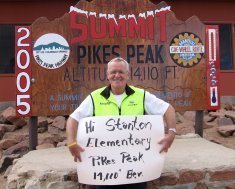
I stopped by Fort Kit Carson and watched the military get ready for a homecoming of their troops who were coming in from their tour in Iraq. I talked to a soldier from Nebraska, Ryan Main, who had helped put the homecoming together. Looking at Ryan I couldn’t believe that I once was that young in uniform. Kit Carson was a famous Army scout from Madison County, KY, who made it to General during his army career.

A salute to all our soldiers! Thank you, Ryan.
I crossed the Royal Gorge Canyon by bicycling
across the highest suspension bridge in the world. Amazing.
I met a 53-year-old North Carolina man traveling by bicycle
named Steve Walters.
Great guy and good to have company for fifty miles up the Arkansas
River.
In Salida outside a grocery store I met an old
gentleman who told me he was a rodeo bronco rider from 1948 to 1960.
I asked him if he knew Deb Copenhaver.
Deb is the world champion bronco rider that I met in
Washington. The 77-year-old
gentleman said, “Sure I know Deb.
He was in the money a whole lot more than I was.”
I asked him if he would like to talk to him.
“Sure,” he answered, in disbelief.
I took my phone out of the pack and called Deb and handed the
phone to the old cowboy.
“This is Deb.” The old
gentleman’s face lit up.
“This is Billy Smity, Deb.
Not the Cody Billy but the one from Colorado.”
It was incredible that I got to hear 30 minutes of
conversation between old cowboy friends who had not spoken to each
other for nearly 50 years.
They had competed against each other for years and it was great
hearing them talk about old times and cowboys who had passed on and
cowboys still around.